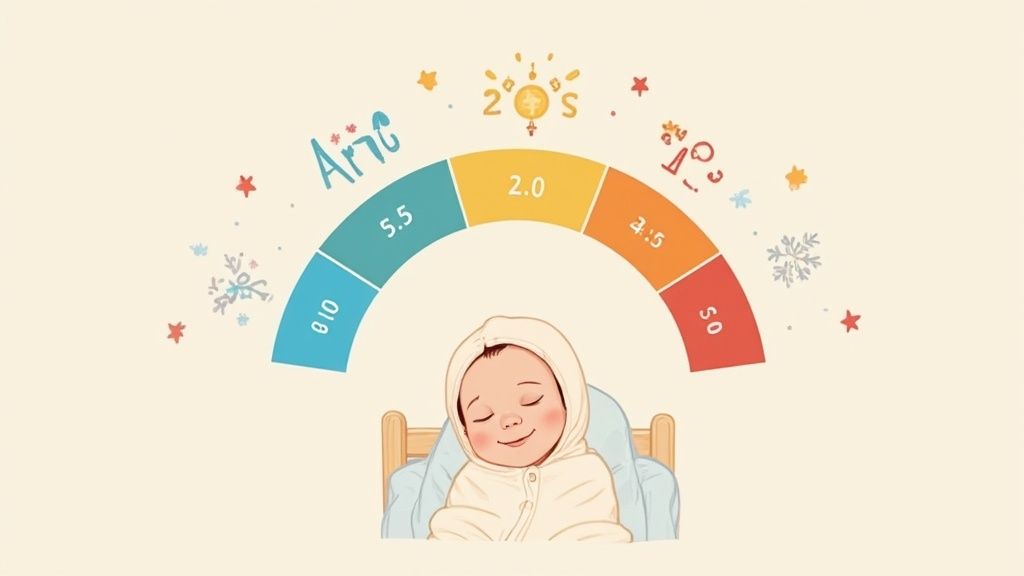
What Is Tog? A Guide to Baby Sleep Sacks
Share
Staring at the tag on a baby sleep sack can feel like you're trying to decipher a secret code. What on earth is a TOG rating?
Think of it like the difference between your own bedding—you've got a light sheet for summer and a thick, cozy duvet for winter. The TOG rating is basically a "coziness score" for your baby's wearable blanket, telling you just how warm it is.
So, What Exactly Is a TOG Rating?
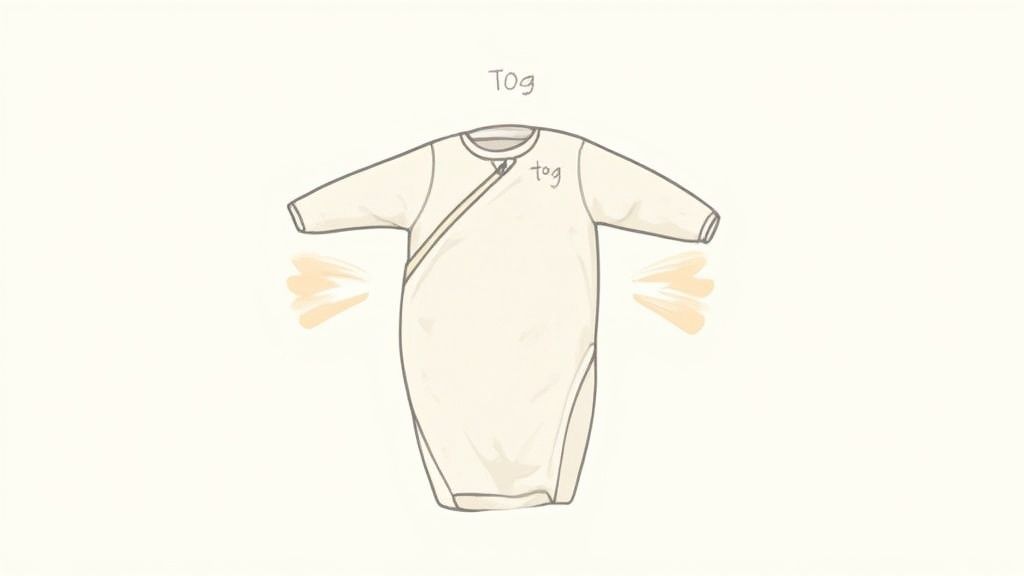
The acronym TOG stands for Thermal Overall Grade. It’s a simple, standardized system that tells you how much heat a fabric will hold onto. The higher the TOG number, the warmer the sleep sack. A low number means you're getting a lighter, more breathable material.
It’s pretty intuitive, really. You wouldn't wear your heavy winter parka on a hot July afternoon, and the same idea applies to dressing your baby for sleep. The TOG rating takes all the guesswork out of it. It helps you pick the right layer to keep your little one perfectly comfortable—never too hot, never too cold.
This little number is your best friend for a safe and comfortable night's sleep. Instead of just feeling the fabric and making a guess, you can make a smart choice based on the actual temperature of your nursery.
The Science Behind It All
While it sounds simple, the TOG rating is a standardized measurement of thermal resistance, used across the textile industry for everything from duvets to baby sleep sacks. To get technical for a second, a 1.0 TOG rating is equal to a thermal resistance of 0.1 m²K/W.
This scientific precision is what makes the system so helpful for parents. You're not relying on vague descriptions like "warm" or "lightweight." The TOG rating gives you a consistent benchmark, no matter the brand or material, which is absolutely key to dressing your baby safely.
A TOG rating isn't just about comfort—it's a crucial safety tool. It helps prevent your baby from overheating, which is a major risk factor for infants, by ensuring they are dressed just right for their sleep environment.
Getting a handle on this system is the first step toward creating the perfect sleep setup for your baby. Once you know how to dress your baby for sleep based on the room temperature and the sleep sack's TOG, you can gain a whole lot of peace of mind.
Why Tog Ratings Are Your Best Friend for Safe Sleep
Dressing your baby for bed is about more than just comfort—it's a massive piece of the safe sleep puzzle. Unlike us, babies are pretty terrible at regulating their own body temperature. This puts them at a much higher risk of overheating, which is a genuine safety concern for any parent.
Think of the TOG rating as your secret weapon. It’s like having a built-in thermostat for your baby's sleepwear, helping you keep them at a stable, safe temperature all night long. Honestly, the peace of mind that comes with that is priceless.
This is especially true when you're using sleep sacks or swaddles. Since your little one can't just kick off a blanket if they get too warm, it's up to us to make sure they aren't too hot or too cold. Getting the layers right helps prevent overheating, a known risk factor associated with SIDS. You can learn more about TOG ratings and baby safety on HappiestBaby.com.
Finding the Safe Sleep Sweet Spot
So, how much of a difference does the right TOG really make? A huge one. Simply choosing a sleep sack with the correct thermal rating for the nursery's temperature dramatically lowers the risk of your baby getting too warm.
This chart really drives the point home, comparing the overheating risk in three different scenarios.
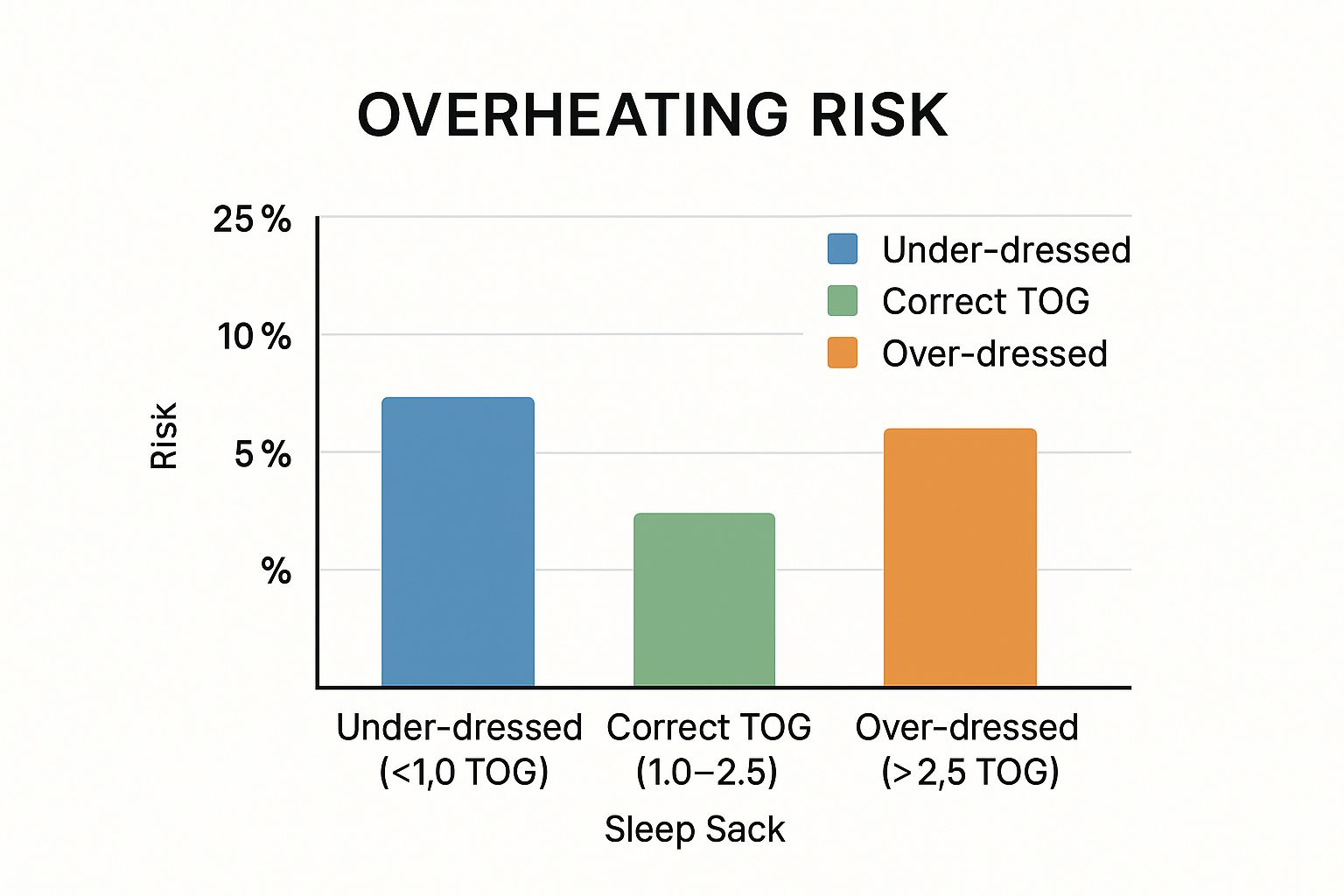
It’s pretty stark when you see it laid out like that. The risk of overheating skyrockets from just 5% to 25% when a baby is in a sleep sack that's too heavy for the room. That number alone shows just how critical the TOG rating is for your baby’s safety.
The goal is always comfortably warm, never hot. Using the right sleep sack also means you don't need any loose blankets in the crib, which is a huge win for creating a safer sleep space.
Of course, what your baby wears underneath the sleep sack is the other half of the equation. Sometimes, you might pair a higher TOG sleep sack with super lightweight pajamas, like the ones in our collection of bamboo baby zipper sleepers, to strike that perfect balance of warmth and safety.
Matching The Right Tog To Your Nursery Temperature
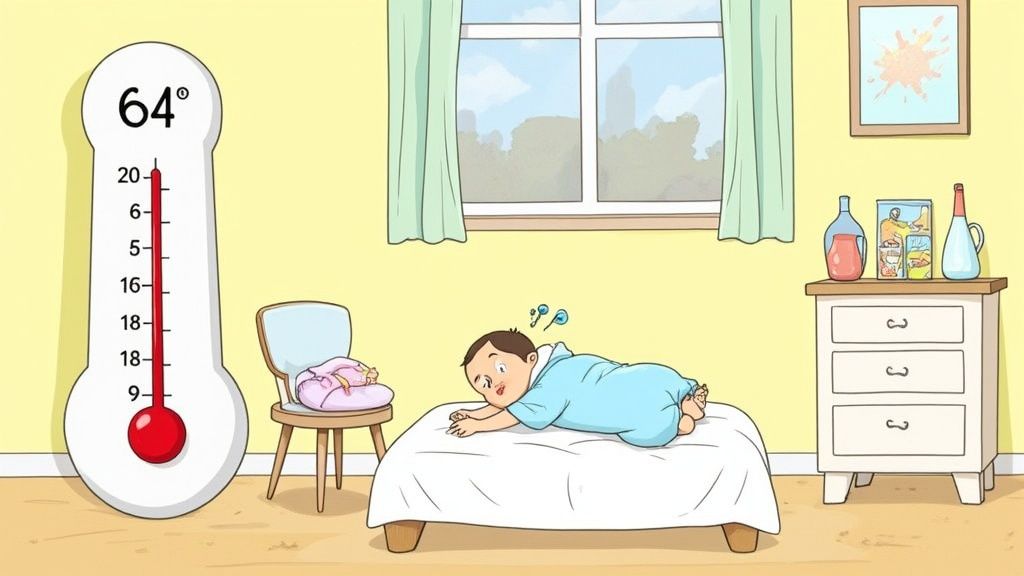
Okay, let's turn all this theory into something you can actually use. You get what TOG ratings are now, but how do you pick the right one for your baby's room tonight? This is where we stop guessing and start making confident choices.
The whole idea is to match the sleep sack's TOG rating to the temperature of your nursery. You don't need any fancy gadgets for this—a regular room thermometer or even the temp reading on your baby monitor works perfectly.
Think of it like dressing your baby in a tiny, perfect climate bubble. You control the room temperature and their wearable blanket. When those two things are in harmony, your baby stays comfortably warm and safe all night, no loose blankets required.
Tog Rating And Room Temperature Guide
To make this super simple, here’s a quick-reference chart. It takes the guesswork out of dressing your baby for sleep. Just find your nursery's temperature and see exactly what you need.
Tog Rating and Room Temperature Guide
This chart helps you match the nursery's temperature to the perfect TOG rating for your baby's sleepwear.
| Room Temperature (°F) | Room Temperature (°C) | Recommended Tog Rating | What Baby Should Wear Underneath |
|---|---|---|---|
| 75-81°F | 24-27°C | 0.5 Tog | A short-sleeved bodysuit or just a diaper. |
| 69-74°F | 21-23°C | 1.0 Tog | A long-sleeved or short-sleeved bodysuit. |
| 61-68°F | 16-20°C | 2.5 Tog | A long-sleeved bodysuit and footed pajamas. |
| Below 61°F | Below 16°C | 3.5 Tog | A long-sleeved bodysuit, pajamas, and even socks if needed. |
Keep this chart handy, and you'll never have to second-guess yourself again.
Putting It Into Practice
Let’s walk through a real-life scenario. It's a chilly winter night, and your nursery is hovering around 64°F (18°C). A quick glance at the chart shows a cozy 2.5 TOG sleep sack is the way to go. Underneath, you’d layer your baby in a long-sleeved bodysuit and some footed pajamas. Perfect.
Now, let's flip it. It's a summer heatwave, and the room is a balmy 77°F (25°C). You'll want to grab a super lightweight 0.5 TOG sleep sack. Your baby might only need their diaper underneath, or maybe a simple short-sleeved bodysuit, to stay cool and comfortable.
One last tip: These are fantastic guidelines, but every baby is a little different. The best way to know for sure is to do a quick check. Just feel the back of their neck or their chest. If it feels comfortably warm (not sweaty or cold), you've nailed it.
Getting the layers right is half the battle. If you're looking for more ideas, check out our guide to some of the best sleeper outfits for babies. Once you get the hang of this system, you’ll be dressing your little one like a pro, helping everyone get a much better night's sleep.
Your Guide to Different TOG Values
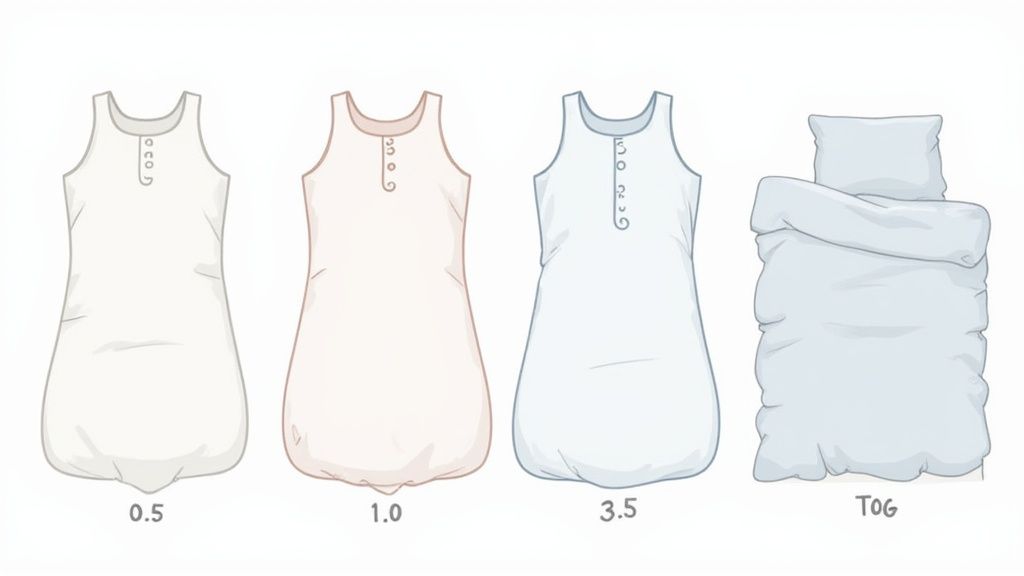
Okay, now that you know how to match a TOG rating with the temperature in your baby’s room, let's talk about what those numbers actually feel like. The easiest way to get your head around it is to compare them to your own bedding. It just clicks.
Each TOG value is tailored for a specific temperature range, making sure your little one stays perfectly comfortable no matter the season.
The Lightweight Layers for Warmer Weather
When things heat up, you'll want to reach for the lowest TOG ratings. These are all about keeping your baby cool and comfortable without them getting sweaty.
- 0.5 TOG: This is the lightest you can get. Think of it like a single, thin cotton sheet on your own bed. It's made for those steamy summer nights and heatwaves, giving your baby that secure, swaddled feeling without adding any real warmth.
- 1.0 TOG: This is your go-to for most of the year. It feels like a light blanket—perfect for those unpredictable spring and fall nights when it’s not too hot and not too cold. Honestly, it’s a staple in just about every parent's closet.
It’s pretty cool how this system is standardized across the textile world. While we focus on a specific range for baby sleepwear, TOG values can be as low as 0.1 for a t-shirt or as high as 10 for a thick winter duvet.
The Cozy Togs for Chilly Nights
When the temperature starts to dip, you'll need sleepwear with more insulation to keep your baby snug. This is how you keep them warm without resorting to loose blankets, which are a big no-no for safe sleep.
The right TOG value takes the guesswork out of dressing your baby for bed. You can just relax, knowing they’re wrapped in the perfect layer of warmth for a safe and sound sleep.
Using a higher TOG sleep sack also means you can often keep your home's thermostat at a lower, more energy-efficient temperature overnight.
- 2.5 TOG: This is your standard winter workhorse. It feels like a plush, cozy comforter and provides plenty of warmth for cold nurseries. It’s insulating but still light enough that your baby won't feel weighed down.
- 3.5 TOG: This is the big gun, reserved for the coldest climates or older, drafty homes. Think of it as an extra-warm, arctic-level duvet. It ensures your baby stays toasty on even the most freezing nights.
The materials often give you a clue about the TOG rating. Lower TOGs are typically made from breathable fabrics like muslin or single-layer bamboo. Higher TOGs usually involve quilted cotton or fleece. If you’re a fan of super-soft, breathable fabrics, you should check out the benefits of bamboo baby pajamas—they make an amazing base layer under any sleep sack.
Common Tog Mistakes and How to Avoid Them
Even with the best of intentions, it's easy to get tangled up when you're first figuring out TOG ratings. Let's walk through a few of the most common mistakes I see parents make, so you can sidestep them and feel totally confident in your choices.
One of the biggest no-nos is adding a loose blanket over a sleep sack "just in case." The whole beauty of a sleep sack is that it's a wearable blanket, designed to be safe on its own. Tossing an extra blanket on top can easily lead to overheating and completely negates the safety aspect.
Trust the system. A sleep sack with the right TOG rating, paired with the appropriate PJs underneath, is all your baby needs.
Checking Your Baby’s Temperature the Right Way
It's almost a reflex to feel your baby's tiny hands or feet to see if they're warm enough, but this can be really misleading. A baby's circulatory system is still a work in progress, which means their hands and feet are often much cooler than the rest of their body.
Feeling chilly fingers might trick you into thinking your baby is cold when they’re actually perfectly comfortable.
The best way to get an accurate read on your baby’s temperature is to feel the back of their neck or their chest. If their skin feels warm and dry to the touch, they're just right. If it feels damp or sweaty, they're too warm.
This simple touch test gives you a much better sense of their core body temperature, helping you avoid adding layers they don't need.
Avoiding These Common Slip-Ups
Beyond those two biggies, a few other little habits can trip parents up. Keep these in mind, and you'll be a pro in no time.
- Forgetting to Adjust for Changes: A room's temperature isn't static. A nursery that's cozy during a sunny afternoon nap can get much cooler by 3 a.m. Always be ready to adjust the TOG rating based on temperature shifts, like a sudden cold front moving in overnight.
- Overdressing Underneath: Remember, the sleep sack itself provides a lot of warmth. Piling on fleece pajamas under a high-TOG sleep sack is a recipe for an overheated baby. Stick to the brand's recommendations for what to wear under each specific TOG value.
- Ignoring Your Baby's Cues: TOG charts are fantastic guidelines, but your baby is the ultimate expert. If your little one consistently seems sweaty in a 1.0 TOG sleep sack in a 70°F room, trust your instincts. It might be time to try a lighter 0.5 TOG instead.
Got Questions About Tog? We’ve Got Answers.
We've thrown a lot of information your way, and it’s totally normal if you’re still trying to piece it all together. Let’s tackle some of the most common questions that pop up for parents just starting to use the TOG system.
Do I Need Different Togs for Naps vs. Nighttime?
Great question! The short answer is, it depends. The real deciding factor isn't the clock on the wall, but the thermometer in the nursery. It's all about the room's temperature while your baby is sleeping.
Think about it: a sun-drenched nursery can get pretty toasty for an afternoon nap. If the room is a warm 75°F (24°C), a lightweight 0.5 TOG sleep sack is probably your best bet. But once the sun goes down, that same room might cool off to 68°F (20°C). In that case, you'll want to swap them into a cozier 2.5 TOG sleep sack for the night. Always dress for the current room temp, not the time of day.
What if My Baby Still Feels Cold in the Recommended Tog?
This is where your parental intuition comes in. TOG charts are fantastic starting points, but they're not one-size-fits-all. Every little one is unique. If you've followed the guide but your baby’s neck or chest feels a bit chilly, it’s perfectly fine to add one more thin layer underneath their sleep sack.
A simple long-sleeved bodysuit is often all it takes. The key is to make small, simple adjustments. Remember to never add a loose blanket in the crib, as this is a major safety hazard.
Parent Pro-Tip: The best way to gauge your baby’s real temperature is to feel the back of their neck or their tummy. Don’t be fooled by cool hands or feet—that's just a normal part of their developing circulation system!
Should I Use a Higher Tog or Just Turn up the Heat?
This one’s easy: always opt for dressing your baby in a higher TOG rather than cranking up the thermostat. A cooler room with cozier layers is widely considered the safest sleep setup for infants.
Experts agree that a room temperature between 68-72°F (20-22°C) is the sweet spot for safe and comfortable sleep. Using the right TOG sleep sack lets you keep the room in that ideal range while making sure your baby stays snug as a bug. It’s a win-win—safer for your baby and a little kinder to your energy bill, too.
Ready to find the perfect sleepwear to keep your little one comfy all year long? At Little Venture Co., our bamboo sleep sacks and pajamas are unbelievably soft and breathable for every season. Explore our faith-inspired collection today!
